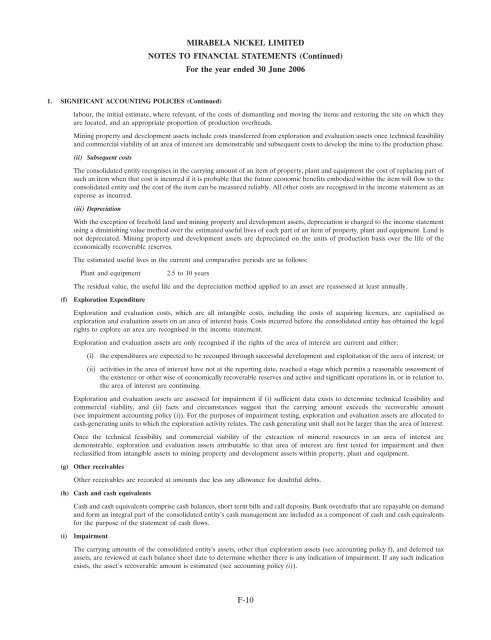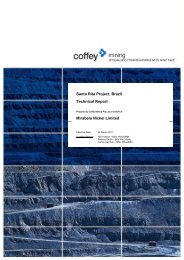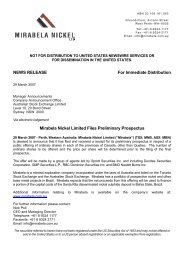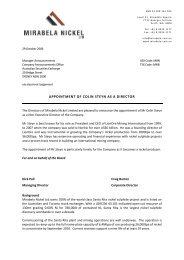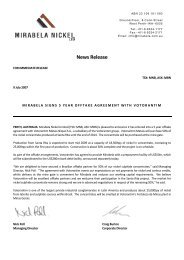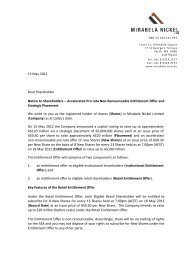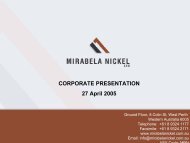COPY OF FINAL PROSPECTUS - Mirabela Nickel
COPY OF FINAL PROSPECTUS - Mirabela Nickel
COPY OF FINAL PROSPECTUS - Mirabela Nickel
You also want an ePaper? Increase the reach of your titles
YUMPU automatically turns print PDFs into web optimized ePapers that Google loves.
MIRABELA NICKEL LIMITED<br />
NOTES TO FINANCIAL STATEMENTS (Continued)<br />
For the year ended 30 June 2006<br />
1. SIGNIFICANT ACCOUNTING POLICIES (Continued)<br />
labour, the initial estimate, where relevant, of the costs of dismantling and moving the items and restoring the site on which they<br />
are located, and an appropriate proportion of production overheads.<br />
Mining property and development assets include costs transferred from exploration and evaluation assets once technical feasibility<br />
and commercial viability of an area of interest are demonstrable and subsequent costs to develop the mine to the production phase.<br />
(ii) Subsequent costs<br />
The consolidated entity recognises in the carrying amount of an item of property, plant and equipment the cost of replacing part of<br />
such an item when that cost is incurred if it is probable that the future economic benefits embodied within the item will flow to the<br />
consolidated entity and the cost of the item can be measured reliably. All other costs are recognised in the income statement as an<br />
expense as incurred.<br />
(iii) Depreciation<br />
With the exception of freehold land and mining property and development assets, depreciation is charged to the income statement<br />
using a diminishing value method over the estimated useful lives of each part of an item of property, plant and equipment. Land is<br />
not depreciated. Mining property and development assets are depreciated on the units of production basis over the life of the<br />
economically recoverable reserves.<br />
The estimated useful lives in the current and comparative periods are as follows:<br />
Plant and equipment<br />
2.5 to 10 years<br />
The residual value, the useful life and the depreciation method applied to an asset are reassessed at least annually.<br />
(f)<br />
Exploration Expenditure<br />
Exploration and evaluation costs, which are all intangible costs, including the costs of acquiring licences, are capitalised as<br />
exploration and evaluation assets on an area of interest basis. Costs incurred before the consolidated entity has obtained the legal<br />
rights to explore an area are recognised in the income statement.<br />
Exploration and evaluation assets are only recognised if the rights of the area of interest are current and either:<br />
(i)<br />
the expenditures are expected to be recouped through successful development and exploitation of the area of interest; or<br />
(ii) activities in the area of interest have not at the reporting date, reached a stage which permits a reasonable assessment of<br />
the existence or other wise of economically recoverable reserves and active and significant operations in, or in relation to,<br />
the area of interest are continuing.<br />
Exploration and evaluation assets are assessed for impairment if (i) sufficient data exists to determine technical feasibility and<br />
commercial viability, and (ii) facts and circumstances suggest that the carrying amount exceeds the recoverable amount<br />
(see impairment accounting policy (i)). For the purposes of impairment testing, exploration and evaluation assets are allocated to<br />
cash-generating units to which the exploration activity relates. The cash generating unit shall not be larger than the area of interest.<br />
Once the technical feasibility and commercial viability of the extraction of mineral resources in an area of interest are<br />
demonstrable, exploration and evaluation assets attributable to that area of interest are first tested for impairment and then<br />
reclassified from intangible assets to mining property and development assets within property, plant and equipment.<br />
(g) Other receivables<br />
Other receivables are recorded at amounts due less any allowance for doubtful debts.<br />
(h) Cash and cash equivalents<br />
Cash and cash equivalents comprise cash balances, short term bills and call deposits. Bank overdrafts that are repayable on demand<br />
and form an integral part of the consolidated entity’s cash management are included as a component of cash and cash equivalents<br />
for the purpose of the statement of cash flows.<br />
(i)<br />
Impairment<br />
The carrying amounts of the consolidated entity’s assets, other than exploration assets (see accounting policy f), and deferred tax<br />
assets, are reviewed at each balance sheet date to determine whether there is any indication of impairment. If any such indication<br />
exists, the asset’s recoverable amount is estimated (see accounting policy (i)).<br />
F-10


